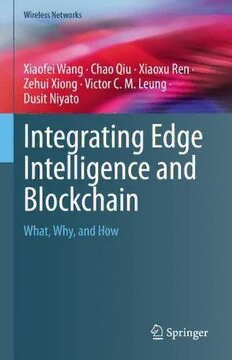
Integrating Edge Intelligence and Blockchain: What, Why, and How PDF
Preview Integrating Edge Intelligence and Blockchain: What, Why, and How
Wireless Networks SeriesEditor XueminShermanShen,UniversityofWaterloo,Waterloo,ON,Canada The purpose of Springer’s Wireless Networks book series is to establish the state of the art and set the course for future research and development in wireless communication networks. The scope of this series includes not only all aspects of wireless networks (including cellular networks, WiFi, sensor networks, and vehicular networks), but related areas such as cloud computing and big data. The series serves as a central source of references for wireless networks research and development. It aims to publish thorough and cohesive overviews on specific topics in wireless networks, as well as works that are larger in scope than survey articles and that contain more detailed background information. The series also providescoverageofadvancedandtimelytopicsworthyofmonographs,contributed volumes,textbooksandhandbooks. **Indexing:WirelessNetworksisindexedinEBSCOdatabasesandDPLB** Xiaofei Wang (cid:129) Chao Qiu (cid:129) Xiaoxu Ren (cid:129) Zehui Xiong (cid:129) Victor C. M. Leung (cid:129) Dusit Niyato Integrating Edge Intelligence and Blockchain What, Why, and How XiaofeiWang ChaoQiu TianjinUniversity TianjinUniversity Tianjin,China Tianjin,China XiaoxuRen ZehuiXiong TianjinUniversity SingaporeUniversityofTechnologyand Tianjin,China Design Singapore,Singapore VictorC.M.Leung DusitNiyato ShenzhenUniversity SchoolofComputerScienceand Shenzhen,China Engineering NanyangTechnologicalUniversity Singapore,Singapore ISSN2366-1186 ISSN2366-1445 (electronic) WirelessNetworks ISBN978-3-031-10185-4 ISBN978-3-031-10186-1 (eBook) https://doi.org/10.1007/978-3-031-10186-1 ©TheEditor(s)(ifapplicable)andTheAuthor(s),underexclusivelicensetoSpringerNatureSwitzerland AG2022 Thisworkissubjecttocopyright.AllrightsaresolelyandexclusivelylicensedbythePublisher,whether thewholeorpartofthematerialisconcerned,specificallytherightsoftranslation,reprinting,reuse ofillustrations,recitation,broadcasting,reproductiononmicrofilmsorinanyotherphysicalway,and transmissionorinformationstorageandretrieval,electronicadaptation,computersoftware,orbysimilar ordissimilarmethodologynowknownorhereafterdeveloped. Theuseofgeneraldescriptivenames,registerednames,trademarks,servicemarks,etc.inthispublication doesnotimply,evenintheabsenceofaspecificstatement,thatsuchnamesareexemptfromtherelevant protectivelawsandregulationsandthereforefreeforgeneraluse. Thepublisher,theauthors,andtheeditorsaresafetoassumethattheadviceandinformationinthisbook arebelievedtobetrueandaccurateatthedateofpublication.Neitherthepublishernortheauthorsor theeditorsgiveawarranty,expressedorimplied,withrespecttothematerialcontainedhereinorforany errorsoromissionsthatmayhavebeenmade.Thepublisherremainsneutralwithregardtojurisdictional claimsinpublishedmapsandinstitutionalaffiliations. ThisSpringerimprintispublishedbytheregisteredcompanySpringerNatureSwitzerlandAG Theregisteredcompanyaddressis:Gewerbestrasse11,6330Cham,Switzerland Preface Alongwiththewaveofinformatizationtechnology,anunprecedentedboomingera of artificial intelligence (AI) has emerged. Meanwhile, with the proliferation of wireless communication, immense volumes of data are generated by mega-scale terminals instead of traditional cloud datacenters. Driving by these trends, edge intelligence(EI)haselicitedescalatingattention.Insteadofentirelyrelyingonthe cloud,EImakesthemostofthewidespreadedgeresourcestogainAIinsight.Itis yetfacingcriticalchallengesinitsdecentralizedmanagementandsecurity,limiting itscapabilitiestosupportserviceswithnumerousrequirements. In this monograph, the blockchain (BC) has been seen as a promising solution to tackle the above issues, further support EI. Based on the number of citations or the relevance of an emerging method, this monograph presents the results of a literature survey on the integration of EI and BC. Accordingly, we conduct a summarization of the recent research efforts on the existing works for EI and BC. We then paint a comprehensive picture of the limitation of EI and why BC could benefit EI. From there, we explore how BC benefits EI in terms of computing powermanagement,dataadministration,andmodeloptimization.Tonarrowthegap betweenimmatureBCandEI-amicableBC,wealsoprobeintohowtotailorBCto EIfromfourperspectives,includingflexibleconsensusprotocol,effectiveincentive, intellectualitysmartcontract,andscalability.Finally,someresearchchallengesand futuredirectionsareaddressed. Tianjin,China XiaofeiWang Tianjin,China ChaoQiu Tianjin,China XiaoxuRen Singapore,Singapore ZehuiXiong Shenzhen,China VictorC.M.Leung Singapore,Singapore DusitNiyato v Acknowledgments This work was supported in part by the National Key R & D Program of China underGrant2019YFB2101901,inpartbytheNationalNaturalScienceFoundation ofChinaunderGrant62072332,andGrant62002260,inpartbytheChinaPostdoc- toralScienceFoundationunderGrant2020M670654,inpartbytheOpenResearch Fund from Guangdong Laboratory of Artificial Intelligence and Digital Economy (SZ) under Grant GML-KF-22-03, in part by the Guangdong Pearl River Talent RecruitmentProgramunderGrant2019ZT08X603,inpartbytheGuangdongPearl River Talent Plan under Grant 2019JC01X235, in part by the Shenzhen Science and Technology Innovation Commission under Grant R2020A045, in part by the National Research Foundation, Singapore and Infocomm Media Development AuthorityunderitsFutureCommunicationsResearch&DevelopmentProgramme, in part by the SUTD SRG-ISTD-2021-165, the SUTD-ZJU IDEA Grant (SUTD- ZJU (VP) 202102), and the SUTD-ZJU IDEA Seed Grant (SUTD-ZJU (SD) 202101). vii Contents 1 Introduction .................................................................. 1 1.1 ABriefIntroductiontoEI .............................................. 1 1.2 ABriefIntroductiontoBC............................................. 2 1.3 OurFocus................................................................ 3 1.4 OurContribution........................................................ 4 References..................................................................... 6 2 OverviewofEdgeIntelligenceandBlockchain........................... 9 2.1 OverviewofEI.......................................................... 9 2.1.1 DefinitionofEI ................................................. 10 2.1.2 DivisionofEI................................................... 10 2.1.3 DeploymentofEI.............................................. 12 2.1.4 ApplicationsofEI.............................................. 14 2.2 OverviewofBC......................................................... 17 2.2.1 DefinitionofBC ................................................ 17 2.2.2 ArchitectureofBC.............................................. 19 2.2.3 CategoriesofBC................................................ 20 2.2.4 ApplicationofBC.............................................. 24 References..................................................................... 26 3 MotivationsforIntegratingEdgeIntelligencewithBlockchain........ 33 3.1 TheLimitationofEI.................................................... 33 3.2 TheBenefitofBC....................................................... 35 3.2.1 Computing-PowerManagement ............................... 36 3.2.2 DataAdministration............................................ 37 3.2.3 ModelOptimization ............................................ 37 References..................................................................... 39 4 BlockchainDrivenEdgeIntelligence ...................................... 43 4.1 BC-DrivenComputing-PowerManagementinEI..................... 43 4.1.1 Value-DrivenComputing-PowerSharing...................... 44 4.1.2 Performance-DrivenComputing-PowerAllocation........... 50 ix x Contents 4.1.3 Service-DrivenComputingOffloading ........................ 52 4.1.4 BCImplementationTutorialforComputing-Power Management .................................................... 55 4.2 BC-DrivenDataAdministrationinEI ................................. 57 4.2.1 IncentiveDataTrading ......................................... 58 4.2.2 DataCachingStrategy.......................................... 59 4.2.3 ReliableDataCollaboration................................... 61 4.2.4 BCImplementationTutorialforDataAdministration........ 65 4.3 BC-DrivenModelOptimizationinEI.................................. 66 4.3.1 HighEfficiencyTraining....................................... 66 4.3.2 CredibleInference.............................................. 72 4.3.3 BCImplementationTutorialforModelOptimization ........ 73 References..................................................................... 75 5 TailoringBlockchaintoEdgeIntelligence................................. 79 5.1 FlexibleConsensusProtocolTailoringToEI.......................... 79 5.1.1 Multi-FunctionalDesign ....................................... 80 5.1.2 CompatibilityEnhancement.................................... 82 5.1.3 AttackDefense.................................................. 85 5.1.4 BCImplementationTutorialforConsensusProtocol Tailoring......................................................... 86 5.2 EffectiveIncentiveMechanismTailoringtoEI........................ 86 5.2.1 MiningStrategyOptimization ................................. 88 5.2.2 RiskPreventionAgainstCryptocurrency...................... 89 5.2.3 BCImplementationTutorialforIncentiveTailoring ......... 90 5.3 IntellectualitySmartContractTailoringtoEI ......................... 90 5.3.1 PerformanceImprovementforSmartContract................ 93 5.3.2 ThreatDetectionAgainstSmartContract ..................... 94 5.3.3 BCImplementationTutorialforSmartContractTailoring... 95 5.4 ScalabilityTailoringtoEI .............................................. 96 5.4.1 ScalabilityImprovement ....................................... 98 5.4.2 BCImplementationTutorialforScalabilityTailoring........ 101 References..................................................................... 101 6 ResearchChallengesandFutureDirections.............................. 105 6.1 ComprehensiveArchitecture ........................................... 105 6.2 QuantizationIntelligence............................................... 106 6.3 TradingIntelligence..................................................... 107 References..................................................................... 108 Conclusions ....................................................................... 109 Index............................................................................... 111 Acronyms 2Ts-DRL Two-timescaledeepreinforcementlearning ACK Acknowledgecharacter ADMM Alternatedirectionmethodofmultipliers AI Artificialintelligence AIE Artificialintelligenceonedge API Applicationprogramminginterface BaaS Blockchain-as-a-service BC Blockchain CD Computing-powerdevice CLI CommandLineInterface CNN Convolutionalneuralnetwork CNN Convolutionalneuralnetwork CNN Proofofwork CSP Computingserviceprovider DAO Decentralizedautomaticorganization DApp Decentralizedapplications DL Deeplearning DLT Distributedledgertechnology DNN Deepneuralnetworks DQL DeepQ-learning DQN DeepQ-network DRGO Deepreinforcementlearningcombinedwithgeneticalgorithm DRL Deepreinforcementlearning DSIC Dominant-strategyincentivecompatibility EC Edgecomputing ECSP Edgecomputingserviceprovider EI Edgeintelligence ePoW Enhancedproofofwork FL Federatedlearning HRL Hierarchicalreinforcementlearning IC Incentivecompatibility xi xii Acronyms IDC Internationaldatacorporation IIoT Industrialinternetofthings IoT Internetofthings IoV Internetofvehicles IR Individualrationality ITS Intelligenttelehealthsystem LM Learningmarkets LSTM Longshort-termmemory MARL Multi-agentreinforcementlearning MDP Markovdecisionprocess ML Machinelearning NFV-MANO Networkfunctionvirtualizationmanagementandorchestration P2P Peer-to-peer PBFT Practicalbyzantinefaulttolerance PoDL Proofofdeeplearning PoET Proofofelapsedtime PoK Proofofknowledge POMDP Partiallyobservablemarkovdecisionprocess PoQ Proofoftrainingquality PoS Proofofstake PoT Proofoftrading PoW Proofofutility QoS Qualityofservice RBFT Redundantbyzantinefaulttolerance UDEC Ultra-denseedgecomputing VANET Vehicleadhocnetwork WAN Wideareanetwork ZB zettabytes
